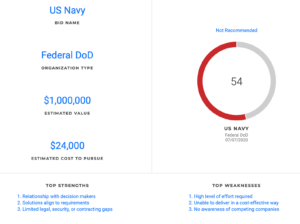Prioritizing “connection” over “correction” with our colleagues may be the key to maintaining high levels of performance and engagement at our companies, according to a recent Forbes article.
Twelve years of leading a mix of sales, proposal, capture and marketing functions at high-growth companies provided a unique view into the forces driving performance, employee engagement and resource investments. Cross-functional leaders at top-performing companies, despite occasional differences in opinion, often found a way to unite and move the company and its customers forward. On the other hand, low-performing, poorly engaged companies seemed to always be in battle between departments over insignificant details, prioritizing correction over connection.
Early in my career, I observed a healthy dose of the latter. Members of my first sales teams shared exaggerations that the only words they heard from the proposal team were “no,” “we’re not pursuing this,” or “if you want to respond, you’ll need to do it yourself.” Yet while managing proposal and capture functions early on, some of the more frequent statements relayed from sales teams were, “yes, we are,” “we should pursue this,” or “isn’t it your job to respond to these opportunities?” to name a few.
The reality is that many statements such as these are delivered within both the high-performing, well-connected companies as much as they are in the low-performing, poorly engaged ones. The difference between the two, I’m convinced, is the presence or lack of context. Context scarcity provokes contention in many organizations and can easily be dismantled by understanding the “why” behind asks and not being too concerned with being right in favor of getting it right.
I found that the teams and individuals investing the time to establish, cultivate, and sustain solidarity and understanding among cross-functional colleagues were more likely to thrive in their markets over time, enjoy higher employee engagement and retention, and produce enormous value for their customers. Everybody won. Decidedly, this effort and subsequent results require time, a great amount of skill and, often, a greater amount of will. So, in this light, let’s explore three keys I found to be most effective for partnering successfully with our friends in sales.
1. Understand sales motivators and performance expectations.
Learn what motivates the sales professionals in your company. How are they compensated? What metrics are they beholden to? How well are they performing against quota and other objectives? How strong are their relationships with customers? These valuable insights are near impossible to surface if we’re only maintaining transactional contact between teams. Create opportunities for sales and proposal teams to connect outside of the high-pressure deliverables to understand mutual motivations, behaviors and strength of customer relationships. To begin these conversations, I’ll shed some light on the questions above:
Compensation and Performance
There’s a saying in the professional world that salespeople are “coin operated,” meaning they’ll only work on things that generate revenue and, therefore, commission in their pockets. Is this accurate? In my experience, yes, simply because most sales compensation plans demand it. Many of the sales teams I managed were compensated on variable plans, with 50% of annual compensation being the base salary and 50% reserved for sales commissions. The variable compensation was proportionate to the percentage of quota achieved. It’s important to note that, according to CSO Insights, the research division for global sales training company Miller Heiman, just over 54% of sales professionals attain quota.
There can be a tremendous amount of stress on these sales professionals if they are underperforming, as some companies are known to implement formal performance plans for sales employees who miss quota for consecutive quarters, followed by termination if the strict plan isn’t met. This, unfortunately, leads to desperation sales efforts and attempts to convince themselves and others that underqualified opportunities are worth pursuing, especially if the sales pipeline is thin.
Conversely, if a sales professional happens to be overachieving on quota, they are often inspired by financial accelerators driving higher commission percentages for every additional piece of revenue over quota. The most innovative of companies also designate a portion of sales compensation to a percentage of recurring customer revenue to promote relationship continuity between the customer and its original seller.
Other Key Metrics
In addition to revenue, sales professionals are often evaluated by their sales pipeline. They are expected to maintain a 3-5x multiple of their annual or quarterly quota in the pipeline. When this metric is observed, realize that the company is only expecting one-third to one-fifth of the pipeline to close as revenue. Sales professionals may also be evaluated by activity metrics, such as phone or email outreach, in addition to the number of product demonstrations on a weekly, monthly or quarterly basis.
Customer Relationships
Strong sales-driven customer relationships are among the greatest assets a company has. Sales professionals become trusted customer partners beginning with the earliest stages of sales cycles, through the acquisition process and on into most details of account management. When customer expectations are met and exceeded, the Customer Lifetime Value can reach a maximum and pay dividends for years to come. As a result, trusted sales professionals play a pivotal role in influencing requirements for future opportunities and remaining a consistent point of reference to help improve product, operations, marketing and other company functions on behalf of the customer. The best sales professionals out there are not only motivated by financial means but by ensuring high levels of satisfaction and value for their customers.
2. Leverage data to help communicate resource allocation decisions.
With a better understanding of sales responsibilities, metrics, motivations and relationships, we can start contextualizing the asks — rational and irrational — that may come to our teams. This is a powerful step forward but only part of the equation. Data should be leveraged in tandem to provide the “why” behind resource allocation decisions.
Consider a new sales professional in your company who, through your mutual investment in making a “connection,” you learned is a bit behind on quota and needs to put some numbers on the board. This person approaches you about a “no-brainer” bid opportunity with the U.S. Navy that was potentially shaped for the company, just waiting to be captured and due in two weeks.
Through your data-backed qualification process thereafter, you find that though the company scored well in the relationship category, it would ultimately require a high level of effort, the company would not be able to deliver in a cost-effective way, and, more importantly, with only two weeks left, it simply may not make sense to invest time and effort on an opportunity that has a low probability of converting into revenue.

Credit: Patri
Our ability to infuse communications with this level of detail to support the “we’re not pursuing this” decision, diffuses tension and redirects the focus of every team to opportunities that are more likely to close with equal effort. With this perspective, any animosity about these decisions can be replaced by gratitude from the honest feedback that puts the best interests of every team at the forefront.
3. Foster an “outward mindset.”
With data in place to support resource allocation decisions and improve cross-team efficiency, and an increased understanding of sales team motivations, performance drivers and customer relationships, the final key to better partner with sales is to focus on what the global training and consulting firm The Arbinger Institute calls the “Outward Mindset.”
Arbinger’s book “Leadership and Self-Deception: Getting Out of the Box” asserts that successful organizations develop “a culture where people are simply invited to see others as people. And being seen and treated straightforwardly, people respond accordingly.”
Sales, proposal, capture and business development teams can mistakenly see one another as objects or vehicles to fulfill their own needs, obstacles that they blame for failures or irrelevancies that they simply ignore. Instead, Arbinger says we should be viewing others as people, with unique desires, challenges, needs and goals that are as relevant as our own.
By connecting this outward mentality with a fresh understanding of motivations, and backing our time and money investment decisions with data in our communications, our teams will more effectively succeed in partnering with the sales organization to fulfill company objectives, propel customer success and improve employee engagement.
Josh Ellars, CEO and Founder of Patri, provides innovative cloud-based software to empower data-driven bid decisions and increase win rates. He has over 11 years of experience in public and private sector proposals, most recently leading marketing and proposals at OpenGov, and prior, launching the public sector business at Qualtrics.



Join the Conversation